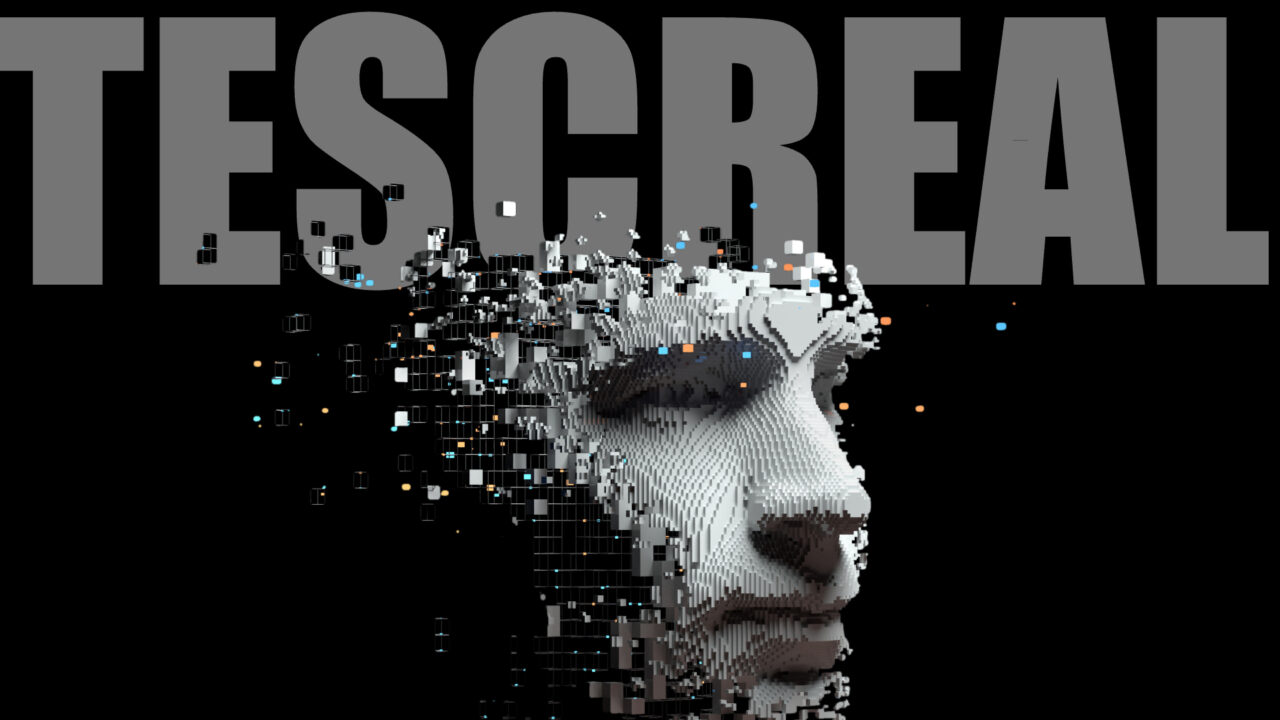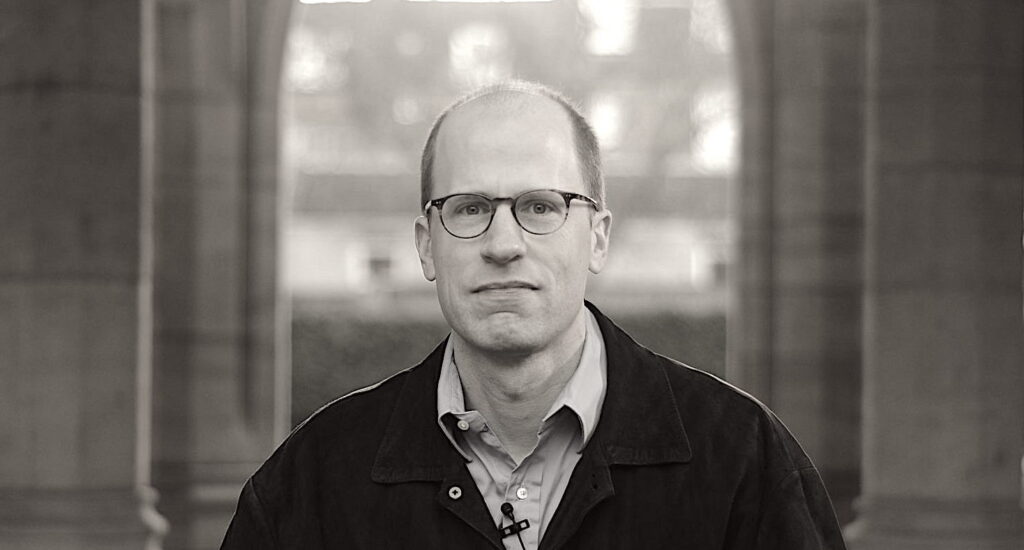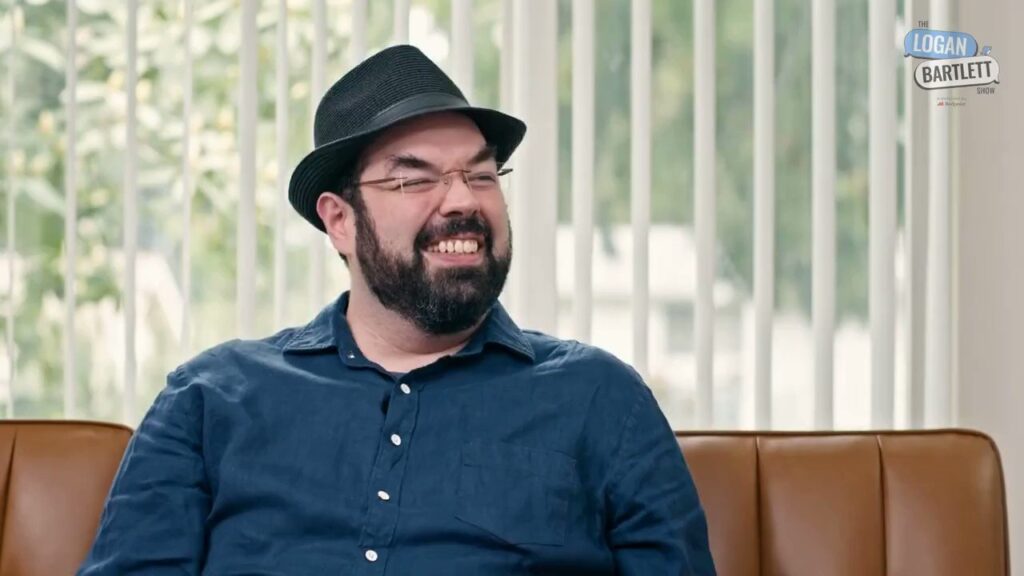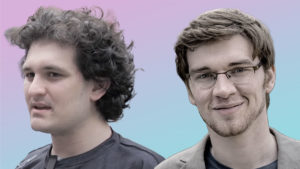The Acronym Behind Our Wildest AI Dreams and Nightmares
To understand the deepening divide between AI boosters and doomers, it’s necessary to unpack their common origins in a bundle of ideologies known as TESCREAL. Image: Truthdig / Adobe
This is Part II of the "Eugenics in the Twenty-First Century: New Names, Old Ideas" Dig series
Image: Truthdig / Adobe
This is Part II of the "Eugenics in the Twenty-First Century: New Names, Old Ideas" Dig series
TESCREAL—pronounced “tess-cree-all.” It’s a strange word that you may have seen pop up over the past few months. The renowned computer scientist Dr. Timnit Gebru frequently mentions the “TESCREAL” ideologies on social media, and for a while the Twitter profile of billionaire venture capitalist Marc Andreessen read: “cyberpunk activist; embracer of variance; TESCREAList.” The Financial Times, Business Insider and VentureBeat have all used or investigated the word. And The Washington Spectator published an article by Dave Troy titled, “Understanding TESCREAL—The Weird Ideologies Behind Silicon Valley’s Rightward Turn.”
My guess is that the acronym will gain more attention as the topic of artificial intelligence becomes more widely discussed, along with questions about the strange beliefs of its most powerful Silicon Valley proponents and critics. But what the heck does “TESCREAL” mean and why does it matter?
I have thought a lot about these questions, as I coined the term in an as-yet unpublished academic paper, co-written with Gebru, tracing the influence of a small constellation of interrelated and overlapping ideologies within the contemporary field of AI. Those ideologies, we believe, are a central reason why companies like OpenAI, funded primarily by Microsoft, and its competitor, Google DeepMind, are trying to create “artificial general intelligence” in the first place.
The problem that Gebru and I encountered when writing our paper is that discussing the constellation of ideologies behind the current race to create AGI, and the dire warnings of “human extinction” that have emerged alongside it, can get messy real fast. The story of why AGI is the ultimate goal— with some seeing ChatGPT and GPT-4 as big steps in this direction — requires talking about a lot of long, polysyllabic words: transhumanism, Extropianism, singularitarianism, cosmism, Rationalism, Effective Altruism and longtermism. I have written about the last two of these in previous articles for Truthdig, which probed how they have become massively influential within Silicon Valley. But you don’t have to look very hard to see their impact, which is pretty much everywhere. “TESCREAL” is one solution to the problem of talking about this cluster of ideologies without a cluttering repetition of almost-impossible-to-pronounce words. John Lennon captured the problem when he sang, “This-ism, that-ism, is-m, is-m, is-m.”

To minimize the “is-m, is-m, is-m,” I proposed the acronym “TESCREAL,” which combines the first letter of the ideologies listed above, in roughly the same order they appeared over the past three and a half decades. Gebru and I thus began to reference the “TESCREAL bundle of ideologies” to streamline our discussion, which gave rise to the terms “TESCREALism” (a reference to the bundle as a whole) and “TESCREAList” (someone who endorses most or all of this bundle). So, we traded a messy list of words for a single clunky term; not a perfect fix, but given the options, a solution we were happy with.
Little that’s going on right now with AI makes sense outside the TESCREAL framework. The overlapping and interconnected ideologies that the “TESCREAL” acronym captures are integral to understanding why billions of dollars are being poured into the creation of increasingly powerful AI systems, and why organizations like the Future of Life Institute are frantically calling for “all AI labs to immediately pause for at least six months the training of AI systems more powerful than GPT-4.” They also explain the recent emergence of “AI doomerism,” led by the TESCREAList Eliezer Yudkowsky, who in a recent TIME op-ed endorsed the use of military strikes against data centers to delay the creation of AGI, including at the risk of triggering an all-out thermonuclear war.
At the heart of TESCREALism is a “techno-utopian” vision of the future. It anticipates a time when advanced technologies enable humanity to accomplish things like: producing radical abundance, reengineering ourselves, becoming immortal, colonizing the universe and creating a sprawling “post-human” civilization among the stars full of trillions and trillions of people. The most straightforward way to realize this utopia is by building superintelligent AGI.
Those ideologies, we believe, are a central reason why companies like OpenAI, funded primarily by Microsoft, and its competitor, Google DeepMind, are trying to create “artificial general intelligence” in the first place.
But then, as the AGI finish line got closer, some began to worry that the whole plan might backfire: AGI could actually turn on its creators, destroying humanity and along with it, this utopian future. Rather than ushering in a paradise among the stars, an AGI built “under anything remotely like the current circumstances” would kill “literally everyone on Earth,” to quote Yudkowsky. Others in the TESCREAL neighborhood, like Andreessen, disagree, arguing that the probability of doom is very low. In their view, the most likely outcome of advanced AI is that it will drastically increase economic productivity, give us “the opportunity to profoundly augment human intelligence” and “take on new challenges that have been impossible to tackle without AI, from curing all diseases to achieving interstellar travel.” Developing AI is thus “a moral obligation that we have to ourselves, to our children and to our future,” writes Andreessen.
Consequently, a range of positions have emerged within the TESCREAL community, from “AI doomers” to “AI accelerationists,” a term that Andreessen included next to “TESCREAList” in his Twitter profile. In between are various “moderate” positions that see the dangers as real but not insuperable, a position exemplified by the Future of Life Institute, which merely calls for a six-month “pause” on AGI research.
While it might appear that “doomers” and “accelerationists” have little in common, the backdrop to the entire debate is the TESCREAL worldview. It is the key to understanding these different schools of thought and the race to AGI that’s catapulted them into the public consciousness. To be clear, Microsoft and Google are of course driven by the profit motive. They expect the AI systems being developed by OpenAI and DeepMind to significantly boost shareholder value. But the profit motive is only part of the picture. The other part, which is no less integral, is the TESCREAL bundle. This is why it’s so important to understand what this bundle is, who embraces it and how it’s driving the push to create AGI.
To see how the TESCREAL ideologies fit together, it’s useful to examine each ideology separately.
The “T” stands for transhumanism. This is the backbone of the TESCREAL bundle. Indeed, the next three letters of the acronym — Extropianism, singularitarianism, and cosmism — are just variations of transhumanism. But we’ll get to them in a moment. The core vision of transhumanism is to technologically reengineer the human species to create a superior new race of “posthumans.” These posthumans would be “superior” by virtue of possessing one or more super-human abilities: immortality, extremely high “IQs,” total control over their emotions, exceptional “rationality” and perhaps new sensory modalities like echolocation, used by bats to navigate the world. Some transhumanists have imagined “enhancing” our moral capacities by slipping “morality-boosting” chemicals into the public water supply, like we do with fluoride.
Essentially, a bunch of 20th-century atheists concluded that their lives lacked the meaning, purpose and hope provided by traditional religion. In response to this realization, they invented a new, secular religion, in which “heaven” is something we create ourselves, in this world. This new religion offered the promise of eternal life, just like Christianity, and has its own version of resurrection: those who don’t become immortal can have their bodies cryogenized by a company named Alcor, based in California, so they can be revived when the technological know-how becomes available. Leading TESCREAList Nick Bostrom is an Alcor customer. Along the same lines, the CEO of OpenAI, Sam Altman, was one of 25 people who signed up with Nectome, a company that preserves people’s brains so they can someday be “uploaded” to a computer — a process that, incidentally, requires euthanizing the customer.

As for God, if he doesn’t exist, then why not just create him? This is what AGI is supposed to be: an all-knowing, all-powerful entity capable of solving all our problems and creating utopia. Indeed, the phrase “God-like AI” has become a popular way of referring to AGI over the past few months. Conversely, if the AGI we build turns on us, it will be a “demon” of our own creation. This is why Elon Musk — who co-founded OpenAI with Altman and others — warned that “with artificial intelligence we are summoning the demon.”
Understanding transhumanism is important not just because of its role in TESCREALism, but because of its ubiquity in Silicon Valley. Tech titans are pouring huge sums of money into realizing the transhumanist project and see AGI as playing an integral part in catalyzing this process. Take Elon Musk’s company Neuralink. Its mission is to merge “your brain with AI,” and in doing so to “jump-start the next stage of human evolution.” This is transhumanism. Or consider that Altman, in addition to signing up with Nectome, secretly donated $180 million to a “longevity” start-up called Retro Biosciences, which aims “to prolong human life by discovering how to rejuvenate our bodies.” This, too, is transhumanism.
Moving on to the next three letters in the “TESCREAL” acronym: Extropianism, Singularitarianism and Cosmism. The first was the original name of the organized transhumanist movement in the late 1980s and early 1990s. It was on the Extropian mailing list that Bostrom sent his now-infamous racist email claiming that “Blacks are more stupid than whites.” (After I discovered this email, he apologized for using the N-word but didn’t walk back his claim about race and “intelligence.”) Singularitarianism is just the idea that the “Singularity” — the moment when the pace of technological development exceeds our comprehension, perhaps driven by an “intelligence explosion” of self-improving AI — will play an integral role in bringing about the techno-utopian future mentioned above, plus a state of radical, post-scarcity abundance. In one popular version, the Singularity enables our posthuman digital descendants to colonize and “wake up” the universe. “The ‘dumb’ matter and mechanisms of the universe will be transformed into exquisitely sublime forms of intelligence,” writes TESCREAList Ray Kurzweil, a research scientist at Google who was personally hired by Larry Page, the company’s co-founder and an adherent of a version of TESCREALism called “digital utopianism.”
While it might appear that “doomers” and “accelerationists” have little in common, the backdrop to the entire debate is the TESCREAL worldview.
If transhumanism is eugenics on steroids, cosmism is transhumanism on steroids. In his “The Cosmist Manifesto,” the former Extropian who christened the now-common term “artificial general intelligence,” Ben Goertzel, writes that “humans will merge with technology,” resulting in “a new phase of the evolution of our species.” Eventually, “we will develop sentient AI and mind uploading technology” that “will permit an indefinite lifespan to those who choose to leave biology behind.” Many of these “uploaded minds” will “choose to live in virtual worlds.” The ultimate aim is to “develop spacetime engineering and scientific ‘future magic’ much beyond our current understanding and imagination,” where such things “will permit achieving, by scientific means, most of the promises of religions — and many amazing things that no human religion ever dreamed.”
This brings us to Rationalism and Effective Altruism. The first grew out of a website called LessWrong, which was founded in 2009 by Yudkowsky, Bostrom’s colleague in the early Extropian movement. Because realizing the utopian visions above will require a lot of really “smart” people doing really “smart” things, we must optimize our “smartness.” This is what Rationalism is all about: finding ways to enhance our “rationality,” which — somewhat humorously — has led some Rationalists to endorse patently ridiculous ideas. For example, Yudkowsky once claimed, based on supposedly “rational” arguments, that it would be better to let “one person be horribly tortured for 50 years without hope or rest” than to allow some very large number of people to experience the nearly imperceptible discomfort of having an eyelash in their eye. Just crunch the numbers and you’ll see that this is true — sometimes you just need to “shut up and multiply,” as Yudkowsky argues.
While Rationalism was spawned by transhumanists, you could see EA as what happens when members of the Rationalist community pivot to questions of ethics. Whereas Rationalism aims to optimize our rationality, EA focuses on optimizing our morality, often using the same tools and methods, such as “expected value theory.” For example, should you go work for an environmental nonprofit or get a job on Wall Street working for a proprietary trading firm like Jane Street Capital? EAs argue that if you crunch the numbers, you can do more overall “good” if you work for an “evil organization” like Jane Street and donate the extra income. In fact, this is exactly what a young EA named Sam Bankman-Fried did after a conversation with one of the cofounders of EA, William MacAskill. A few years later, Bankman-Fried came to believe he might be better positioned to “get filthy rich, for charity’s sake” — as one journalist put it — if he started his own cryptocurrency company, which he did, resulting in Alameda Research and FTX. Bankman-Fried now faces up to 155 years in prison for allegedly committing “one of the biggest financial frauds in history.”
Like Rationalists, EAs are obsessed with “intelligence,” “IQ,” and a particular interpretation of “rationality.” One former EA reported in Vox that EA leaders tested a ranking system of community members in which those with IQs less than 120 would get points subtracted from their score card. EAs would also get points added if they focused on “longtermist” issues like AGI safety, whereas they’d lose points if they “worked to reduce global poverty or mitigate climate change.” This brings us to the final letter in the acronym:
Longtermism, which emerged out of the EA movement and is probably EAs most significant contribution to the TESCREAL bundle. If transhumanism is the backbone of TESCREALism, longtermism is the “galaxy brain” sitting atop it. What happened is that, in the early 2010s, a bunch of EAs realized that humanity can theoretically exist on Earth for another 1 billion years, and if we spread into space, we could persist for at least 10^40 years (that’s a 1 followed by 40 zeros). More mind-blowing was the possibility of these future people living in vast computer simulations running on planet-sized computers spread throughout the accessible cosmos, an idea that Bostrom developed in 2003. The more people who exist in this “Matrix”-like future, the more happiness there could be; and the more happiness, the better the universe will become.

Hence, if your aim is to positively influence the greatest number of people possible, and if most people who could exist will live in the far future, then it’s only “rational” to focus on them rather than current day people. According to Bostrom, the future could contain at least 10^58 digital people in virtual-reality worlds (a 1 followed by a mind-boggling 58 zeros). Compare that to the 1.3 billion people in multidimensional poverty today, which absolutely pales in comparison. This is why longtermists concluded that improving these future people’s lives — indeed, making sure that they exist in the first place — should be our top global priority. Furthermore, since creating a “safe” AGI would greatly increase the probability of these people existing, longtermists pioneered the field of “AI safety,” which aims to ensure that whatever AGI we build ends up being a “God” rather than “demon.”
If transhumanism is the backbone of TESCREALism, longtermism is the “galaxy brain” sitting atop it.
Like transhumanism, Rationalism, and EA, longtermism boasts of a large following in Silicon Valley and among the tech elite. Last year, Elon Musk retweeted a paper by Bostrom, one of the founding documents of longtermism, with the line: “Likely the most important paper ever written.” After MacAskill published a book on longtermism last summer, Musk described it as “a close match for my philosophy.” Longtermism is the backdrop to Musk’s claims that “we have a duty to maintain the light of consciousness, to make sure it continues into the future,” and that “what matters … is “maximizing cumulative civilizational net happiness over time.” And although Altman has questioned the “branding” of longtermism, it’s what he gestures at in saying that building a safe AGI is important because“galaxies are indeed at risk.” As alluded to earlier, the founding of companies like OpenAI and DeepMind were partly the result of longtermists. An early investment in DeepMind, for example, was made by Jaan Tallinn, a prominent TESCREAList who also co-founded the Centre for the Study of Existential Risk at Cambridge and the Future of Life Institute, itself largely funded by the crypto millionaire Vitalik Buterin, himself a TESCREAList. Five years after DeepMind was formed, Musk and Altman then joined forces with other Silicon Valley elite, such as Peter Thiel, to start OpenAI.
Longtermism is also a major reason for the “doomer” freak-out over AGI being built in the near future, before we can figure out how to make it “safe.” According to the longtermist framework, the biggest tragedy of an AGI apocalypse wouldn’t be the 8 billion deaths of people now living. This would be bad, for sure, but much worse would be the nonbirth of trillions and trillions of future people who would have otherwise existed. We should thus do everything we can to ensure that these future people exist, including at the cost of neglecting or harming current-day people — or so this line of reasoning straightforwardly implies. This is why Yudkowsky recently contended that risking an all-out thermonuclear war on Earth is worth it to avert an AGI apocalypse. The argument is that, while an AGI apocalypse would kill everyone on Earth, thermonuclear war almost certainly wouldn’t. At least with thermonuclear war, then, there’d still be a chance of eventually colonizing space and creating utopia, after civilization rebuilds. When asked “How many people are allowed to die to prevent AGI?,” Yudkowsky thus replied:
There should be enough survivors on Earth in close contact to form a viable reproductive population, with room to spare, and they should have a sustainable food supply. So long as that’s true, there’s still a chance of reaching the stars someday.
This is the dark side of TESCREALism — it’s one reason I’ve argued that this bundle, especially the “galaxy brain” at the top — longtermism — could be profoundly dangerous. If the ends can sometimes justify the means, and if the end is a utopian paradise full of literally astronomical amounts of “value,” then what exactly is off the table for protecting this future? The other dark side of TESCREALism is its accelerationist camp, which wants humanity to rush headlong into creating increasingly powerful technologies with little or no regulation. Doing so is bound to leave a trail of destruction in its wake.
What links these two extremes — along with the “moderate” positions in the middle — is a fundamentalist belief that advanced technologies are our ticket to a world in which, as Altman writes in an OpenAI blog post, “humanity flourishes to a degree that is probably impossible for any of us to fully visualize yet.” TESCREALism is the worldview based on this grand vision, which grew from the overlapping movements and ideologies discussed above.
It may be somewhat obvious at this point why the TESCREAL ideologies comprise a “bundle.” You can think of them as forming a single entity extended across time, from the late 1980s up to the present, with each new ideology arising from and being shaped by previous ones. Put differently, the emergence of these ideologies looks a lot like suburban sprawl, resulting in a cluster of municipalities without any clear borders between them — a conurbation of movements that share much the same ideological real estate. In many cases, the individuals who influenced the development of one also shaped many others, and the communities that coalesced around each letter in the acronym have always overlapped considerably. Let’s define a “TESCREAList” as anyone who’s linked to more than one of these ideologies. Examples include Bostrom, Yudkowsky, MacAskill, Musk, Altman and Bankman-Fried.
(The only ideology that’s mostly defunct is Extropianism, having merged into subsequent ideologies while passing along its commitment to values like “perpetual progress,” “self-transformation,” “rational thinking” and “intelligent technology.” The role of Extropianism in the formation of TESCREALism and its continuing legacy are why I include it in the acronym.)
There are many other features of TESCREALism that justify thinking of it as a single bundle. For example, it has direct links to eugenics, and eugenic tendencies have rippled through just about every ideology that comprises it. This should be unsurprising given that transhumanism — the backbone of TESCREALism — is itself a form of eugenics called “liberal eugenics.” Early transhumanists included some of the leading eugenicists of the 20th century, most notably Julian Huxley, president of the British Eugenics Society from 1959 to 1962. I wrote about this at length in a previous Truthdig article, so won’t go into details here, but suffice it to say that the stench of eugenics is all over the TESCREAL community. Several leading TESCREALists, for instance, have explicitly worried about “less intelligent” people outbreeding their “more intelligent” peers. If “unintelligent” people have too many children, then the average “intelligence” level of humanity will decrease, thus jeopardizing the whole TESCREAL project. Bostrom lists this as a type of “existential risk,” which essentially denotes any event that would prevent us from creating a posthuman utopia among the heavens full of astronomical numbers of “happy” digital people. In Bostrom’s words,
it is possible that advanced civilized society is dependent on there being a sufficiently large fraction of intellectually talented individuals. Currently it seems that there is a negative correlation in some places between intellectual achievement and fertility. If such selection were to operate over a long period of time, we might evolve into a less brainy but more fertile species, homo philoprogenitus (“lover of many offspring”).
This leads to another characteristic of the TESCREAL community: many members see themselves as quite literally saving the world. Sometimes this is made explicit, as when MacAskill — co-founder of EA, leading longtermist, and advocate of transhumanism — writes that “to save the world, don’t get a job at a charity; go work on Wall Street.” Luke Muehlhauser, a TESCREAList who used to work with Yudkowsky on AI safety issues, similarly declares:
The world cannot be saved by caped crusaders with great strength and the power of flight. No, the world must be saved by mathematicians, computer scientists, and philosophers.
By which he means, of course, TESCREALists.
One of the central aims of the TESCREAL community is to mitigate existential risk. By definition, this means increasing the probability of a utopian world of astronomical “value” someday existing in the future. Hence, to say “I’m working to mitigate existential risks” is another way of saying, “I’m trying to save the world — the world to come, utopia.” As one scholar puts it, “the stakes are so high that those involved in this effort will have earned their keep even if they reduce the probability of a catastrophe by a tiny fraction.” Bostrom argues that if there’s a mere 1% chance of 10^52 digital lifetimes existing in the future, then “the expected value of reducing existential risk by a mere one billionth of one billionth of one percentage point is worth a hundred billion times as much as a billion human lives.” In other words, if you mitigate existential risk by this minuscule amount, then you’ve done the moral equivalent of saving billions and billions of existing human lives.
This grandiose sense of self-importance is evident in the names of leading TESCREAL organizations, such as the Future of Humanity Institute at Oxford, founded by Bostrom in 2005, and the Future of Life Institute, which aims “to help ensure that the future of life exist[s] and [is] as awesome as possible” and originally included Bostrom on its Scientific Advisory Board.
The belief that TESCREALists trying to mitigate existential risks are doing something uniquely important — saving the world — is also apparent in an attitude that many express toward “nonexistential” threats to humanity. Social justice provides a good example. After Bostrom’s racist email came to light earlier this year, he released a sloppily written “apology” and griped on his personal website about “a swarm of bloodthirsty mosquitoes” distracting him “from what’s important” — a clear reference to the social justice activists who were upset with his behavior. When one believes they are literally saving the world, everything else looks trivial by comparison.
This is yet another reason I believe the TESCREAL bundle poses a serious threat to people in the present, especially those who aren’t as privileged and well-off as many leading TESCREALists. As Bostrom once quipped, catastrophes that don’t threaten our posthuman future among the heavens are nothing more than “mere ripples on the surface of the great sea of life.” Why? Because they won’t “significantly affect the total amount of human suffering or happiness or determine the long-term fate of our species.” “Giant massacres for man,” are but “small missteps for mankind.”
When one believes they are literally saving the world, everything else looks trivial by comparison.
Perhaps the most important feature of the TESCREAL bundle as a whole is its enormous influence. Together, these ideologies have given rise to a normative worldview — essentially, a “religion” for atheists — built around a deeply impoverished utopianism crafted almost entirely by affluent white men at elite universities and in Silicon Valley, who now want to impose this vision on the rest of humanity — and they’re succeeding. This is why TESCREALism needs to be named, called out and criticized. Although not every TESCREAList holds the most radical views found in the community, the most radical views are often championed by the most influential figures. Bostrom, Musk, Yudkowsky and MacAskill have all made claims that would give most people shivers. MacAskill, for example, argues in his 2022 book “What We Owe the Future” that, in order to keep the engines of economic growth roaring, we should consider replacing human workers with digital workers. “We might develop artificial general intelligence (AGI),” he writes, “that could replace human workers — including researchers. This would allow us to increase the number of ‘people’ working on R&D as easily as we currently scale up production of the latest iPhone.”
Does this sound like utopia or a dystopia? Later he declares that our obliteration of the natural world might be “a good thing,” since there’s a lot of wild-animal suffering in nature, and hence the fewer wild animals there are, the less wild-animal suffering. On this view, nature itself might not have a place in the TESCREAList future.
If TESCREALism was not an ascendant ideology within some of the most powerful sectors of society, we might chuckle at all of this, or just roll our eyes. But the frightening fact is that the TESCREAL bundle is already shaping our world, and the world of our children, in profound ways. Right now, the media, the public, policymakers and our political leaders know little about these ideologies. As someone who participated in the TESCREAL movement over the past decade, but who now views it as a destructive and dangerous force in the world, I feel a moral obligation to educate people about what’s going on. Although the term “TESCREAL” is strange and clunky, it holds the keys to making sense of the “accelerationist” push to develop AGI as well as the “doomer” backlash against recent advancements, driven by fears that AGI — if created soon — might annihilate humanity rather than ushering in a utopian paradise.
If we are to have any hope of counteracting this behemoth, it is critical that we understand what “TESCREAL” means and how these ideologies have infiltrated the highest echelons of power. To date, the TESCREAL movement has been subject to precious little critical inquiry, let alone resistance. It’s time for that to change.
Your support matters…Independent journalism is under threat and overshadowed by heavily funded mainstream media.
You can help level the playing field. Become a member.
Your tax-deductible contribution keeps us digging beneath the headlines to give you thought-provoking, investigative reporting and analysis that unearths what's really happening- without compromise.
Give today to support our courageous, independent journalists.







You have brilliantly dissected the cultic aspects of their delusionary and narcissistic grandiosity. Writing from a Freudian perspective, I have looked at their "hyper-cerebral," emotionally arrested (and probably sexually inhibited and/or perverse) personality-type: a quest to "escape," not only death, but all those troublesome "id" drives and needs of being a mammalian species, Homo sapiens. (cf. my "Evolved Homo Sapiens--not a Machine" and similar articles at: dissidentvoice. org). Your outstanding article, carefully nuanced, is cutting-edge...
You have brilliantly dissected the cultic aspects of their delusionary and narcissistic grandiosity. Writing from a Freudian perspective, I have looked at their "hyper-cerebral," emotionally arrested (and probably sexually inhibited and/or perverse) personality-type: a quest to "escape," not only death, but all those troublesome "id" drives and needs of being a mammalian species, Homo sapiens. (cf. my "Evolved Homo Sapiens--not a Machine" and similar articles at: dissidentvoice. org). Your outstanding article, carefully nuanced, is cutting-edge in its insights! Best regards, william manson, ph.d. ([email protected])